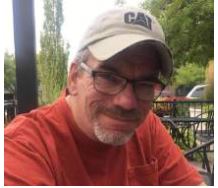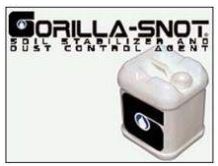Protecting Ground Systems is Snot Hard

[August 2019] In an article from 2008, Jay White described a tactic to reduce copper theft by using a transparent, bio-degradable product he called “Glue,” which, when applied, essentially cemented together the soil particles around the ground system.
Several readers wrote or called for more information, so we decided to ask Jay to give us some more specifics. He did.
As with the previous article, we felt that bringing this back 10 years later was a good idea.
Do you need to protect your ground radials in soft soils and/or sand?
If so, I would recommend that you try some Gorilla Snot (www.gorilla-snot.com). Or perhaps Rhino Snot (www.envirotac.com). Or one of the several other trade-named products for which contractors simply call “Glue.” You can follow the links for more information.
After my previous article, telling the tale of how we got there, many of you were interested in finding out more information about these soil fixatives.
Rewind
In January of 2007, about half of the ground system for Morris’ owned KNWQ-AM in Palm Springs, California was stolen.
The thieves did not have to work too hard at it. At the time, it was an easy operation for them to find a radial in the sand and just pull it up. Using hooks and trucks, it took just over a half an hour to remove the radials from two towers. A repetition was not desirable.
We needed to protect our new ground system after installation, and the best solution seemed to be deterring further theft by making the radials more difficult to steal. The theory was that if a thief has to work too hard to retrieve their reward, they just will not bother.
I took some time to learn about soil stabilization and fixatives from a local contractor, and was convinced that if we applied the right product thickly enough, it could probably do a good job of sealing the ground system into the ground. A pick and shovel would need to be used along the length of the radial to unbury it – something that should discourage most thieves.
Another Consideration
In addition to the theft problem, KNWQ is located in an area where winds are constant.
Those of you who deal with this sort of situation, know there is really no easy way to keep up with the wind erosion. Eventually, the radials start to “emerge” from the ground and become a problem – not the least of which is becoming an “attractive nuisance.”
We did try installing a fence around the site to preclude off-road access to the site by the general public (the main concern was someone being hurt on the property) so as to protect the ground system from damage. Nevertheless, the wind continued to expose a number of ground radials around a couple of the towers.
What It Is
During my research, I found several sites like www.Gorilla-Snot.com.
That site describes their product as “a polymer-based emulsion used primarily to stabilize all soils from dust and erosion. It is specifically engineered for ease of use for large commercial projects down to smaller residential applications. It can be as simple to apply as watering the ground.
“Furthermore, Gorilla-Snot is designed to work its way down into the soil to maximize the penetration depth. The result is a thicker protective barrier with a more rigid and stable base.”
While easy application is important, it is the “staying power” that is of special concern to us broadcast engineers, in order to protect the radials in the ground system.
The Web site continues: “Once cured, Gorilla-Snot becomes completely transparent, leaving the natural landscape to appear untouched.
 “Gorilla-Snot results are based on the application rate used. Modest applications can create a light temporary surface crust that is permeable by water and is useful for dust control needs.
“Gorilla-Snot results are based on the application rate used. Modest applications can create a light temporary surface crust that is permeable by water and is useful for dust control needs.
“On the other hand, heavy applications can generate results similar to the qualities of cement. Most importantly, Gorilla-Snot is a truly biodegrade-able product that is completely environmentally safe to use.”
Results of Application
Application was accomplished at the KNWQ site in one long day using a water truck and spray canon.
The product was applied thicker closer to the tower and less thick farther out.
It hardened in about a day. Afterward one can actually walk on top of the sand.
We did an inspection of the site after KNWQ’s soils fixative had been in place for about a year. Since, after curing, the sand was essentially one huge slab, there has been no wind erosion.
A heavy rain that fell over the following winter did nothing to the surface. This is because, once cured, the product is no longer water soluble and therefore will not wash away nor dissipate.
All in all, the site looked like it did the day they finished applying the stabilizer and also appeared to be good for weed abatement.
More importantly, the new ground system was still intact.
– – –
A veteran broadcast engineer for nearly 40 years, Jay White is the Engineering Manager for Townsquare Media in the Tri-Cities and Yakima Washington markets.
You can contact Jay at:
morelisteners@gmail.com
